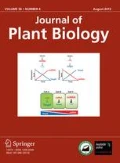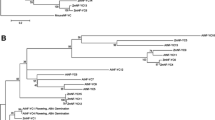Abstract
Upward Curly Leaf 1 (UCL1) is an Arabidopsis thaliana E3 ligase that targets the Curly Leaf (CLF) SET-domain polycomb-group (PcG) protein for degradation via the ubiquitin-26S proteasome system. UCL1 is a paternally-expressed imprinted gene in the endosperm. To precisely locate the promoter elements required for UCL1 imprinting pattern, various gene constructs were created in which the imprinting control region (ICR), endosperm-specific expression (ENSE) element, and/or the linker sequence were altered. By fusing these constructs with a GUS reporter gene, GUS expression patterns were monitored after reciprocal crosses with wild-type Columbia-0 allowing the determination of parent-of-origin expression. Analysis of publicly-available data on the UCL1 promoter region facilitated the search for allele-specific DNA and H3K27 methylation patterns. Overall, three promoter elements are required for maternal repression of UCL1; the ICR sequence located from − 2.5 to − 2.4 kb upstream of the translation start site, a differentially methylated region 2 (DMR2) that overlaps the short ATLINE1-1 transposable element in the linker region, and a minimal 271 bp ENSE element. In addition, DNA methylation patterns in the DMR2 contribute to the repression of the maternal UCL1 allele. Our findings would help to understand how parent-of-origin epigenetic patterns are created and maintained in the endosperm.






Similar content being viewed by others
References
Barlow DP (1993) Methylation and imprinting: from host defense to gene regulation? Science 260(5106):309–310
Bogdanovic O, Long SW, van Heeringen SJ, Brinkman AB, Gomez-Skarmeta JL, Stunnenberg HG, Jones PL, Veenstra GJ (2011) Temporal uncoupling of the DNA methylome and transcriptional repression during embryogenesis. Genome Res 21(8):1313–1327
Bracken AP, Dietrich N, Pasini D, Hansen KH, Helin K (2006) Genome-wide mapping of Polycomb target genes unravels their roles in cell fate transitions. Genes Dev 20(9):1123–1136
Choi J, Hyun Y, Kang MJ, In Yun H, Yun JY, Lister C, Dean C, Amasino RM, Noh B, Noh YS, Choi Y (2009) Resetting and regulation of Flowering Locus C expression during Arabidopsis reproductive development. Plant J 57(5):918–931
Choi Y, Gehring M, Johnson L, Hannon M, Harada JJ, Goldberg RB, Jacobsen SE, Fischer RL (2002) DEMETER, a DNA glycosylase domain protein, is required for endosperm gene imprinting and seed viability in Arabidopsis. Cell 110(1):33–42
Czermin B, Melfi R, McCabe D, Seitz V, Imhof A, Pirrotta V (2002) Drosophila enhancer of Zeste/ESC complexes have a histone H3 methyltransferase activity that marks chromosomal Polycomb sites. Cell 111(2):185–196
Garnier O, Laoueille-Duprat S, Spillane C (2008) Genomic imprinting in plants. Epigenetics 3(1):14–20
Gehring M (2013) Genomic imprinting: insights from plants. Annu Rev Genet 47:187–208
Gehring M, Huh JH, Hsieh TF, Penterman J, Choi Y, Harada JJ, Goldberg RB, Fischer RL (2006) DEMETER DNA glycosylase establishes MEDEA polycomb gene self-imprinting by allele-specific demethylation. Cell 124(3):495–506
Haig D (1997) Parental antagonism, relatedness asymmetries, and genomic imprinting. Proc Biol Sci R Soc 264(1388):1657–1662
Haig D, Westoby M (1989) Parent-specific gene expression and the triploid endosperm. Am Nat 134:147–155
Hennig L, Derkacheva M (2009) Diversity of Polycomb group complexes in plants: same rules, different players? Trends Genet 25(9):414–423
Hershko A, Ciechanover A (1998) The ubiquitin system. Annu Rev Biochem 67:425–479
Hsieh TF, Ibarra CA, Silva P, Zemach A, Eshed-Williams L, Fischer RL, Zilberman D (2009) Genome-wide demethylation of Arabidopsis endosperm. Science 324(5933):1451–1454
Ibarra CA, Feng X, Schoft VK, Hsieh TF, Uzawa R, Rodrigues JA, Zemach A, Chumak N, Machlicova A, Nishimura T, Rojas D, Fischer RL, Tamaru H, Zilberman D (2012) Active DNA demethylation in plant companion cells reinforces transposon methylation in gametes. Science 337(6100):1360–1364
Iwasa Y (1998) The conflict theory of genomic imprinting: how much can be explained? Curr Top Dev Biol 40:255–293
Jeong CW, Park GT, Yun H, Hsieh TF, Choi YD, Choi Y, Lee JS (2015) Control of paternally expressed imprinted UPWARD CURLY LEAF1, a gene encoding an F-Box protein that regulates CURLY LEAF polycomb protein, in the Arabidopsis Endosperm. PLoS ONE 10(2):e0117431
Jeong CW, Roh H, Dang TV, Choi YD, Fischer RL, Lee JS, Choi Y (2011) An E3 ligase complex regulates SET-domain polycomb group protein activity in Arabidopsis thaliana. Proc Natl Acad Sci U S A 108(19):8036–8041
Jullien PE, Kinoshita T, Ohad N, Berger F (2006) Maintenance of DNA methylation during the Arabidopsis life cycle is essential for parental imprinting. Plant Cell 18(6):1360–1372
Kinoshita T, Miura A, Choi Y, Kinoshita Y, Cao X, Jacobsen SE, Fischer RL, Kakutani T (2004) One-way control of FWA imprinting in Arabidopsis endosperm by DNA methylation. Science 303(5657):521–523. https://doi.org/10.1126/science.1089835
Makarevich G, Villar CB, Erilova A, Kohler C (2008) Mechanism of PHERES1 imprinting in Arabidopsis. J Cell Sci 121(Pt 6):906–912
Margueron R, Reinberg D (2010) Chromatin structure and the inheritance of epigenetic information. Nat Rev Genet 11(4):285–296
Mozgova I, Kohler C, Hennig L (2015) Keeping the gate closed: functions of the polycomb repressive complex PRC2 in development. Plant J 83(1):121–132
Park K, Kim MY, Vickers M, Park JS, Hyun Y, Okamoto T, Zilberman D, Fischer RL, Feng X, Choi Y, Scholten S (2016) DNA demethylation is initiated in the central cells of Arabidopsis and rice. Proc Natl Acad Sci U S A 113(52):15138–15143
Schwartz YB, Pirrotta V (2008) Polycomb complexes and epigenetic states. Curr Opin Cell Biol 20:266–273
Xiao J, Wagner D (2015) Polycomb repression in the regulation of growth and development in Arabidopsis. Curr Opin Plant Biol 23:15–24
Acknowledgements
The work was supported by NRF of Korea (2015R1A2A2A01004095) to J.S.L. This work was also supported by NRF of Korea (2020R1A2C2009382) to Y.C. Both J.H. and J.L. were supported by the Stadelmann-Lee Scholarship Fund, Seoul National University.
Author information
Authors and Affiliations
Contributions
JH, YC, and JSL conceived and designed the study. JH, JL and CWJ performed the experiments. JH, JL, CWJ, JSB, YC and JSL analyzed the data. JSB and YC wrote the manuscript with the contribution of JH, JL, CWJ and JSL.
Corresponding authors
Ethics declarations
Conflict of interest
The authors declare that they have no conflict of interest.
Electronic supplementary material
Below is the link to the electronic supplementary material.
12374_2020_9256_MOESM1_ESM.tif
Supplementary Figure S1. Allele-specific differentially methylated regions (DMR) of UCL1 5’ upstream in wild type and dme mutant endosperm. Percentage of CpG methylation in the DMR regions of the female (Col-0) and male (Ler) in the endosperm are shown. Whereas the silenced UCL1 maternal allele (Col-0) shows hypomethylaiton, the expressed paternal UCL1 allele (Ler) shows hypermethylation in the endosperm. In dme mutant, maternal allele shows increased methylation that results in the de-repression of the maternal allele (Jeong et al. 2015). The data were extracted from the published whole genome-wide DNA methylome in the endosperm (Ibarra et al. 2012) (TIF 1318 kb)
12374_2020_9256_MOESM2_ESM.tif
Supplementary Figure S2. H3K27me3 pattern in 5’ upstream region of UCL1. Red arrow indicates -1814 bp to -1478 bp upstream of UCL1 translation start codon, that is predicted to be differentially methylated region (DMR2). The pattern of H3K27me3 is found around the DMR2 without overlap with the DMR2 (TIF 878 kb)
Rights and permissions
About this article
Cite this article
Hong, J., Lee, J., Jeong, C.W. et al. Identification of Elements Responsible for Maternally-Silenced Imprinted Gene Expression of Upward Curly Leaf1, an F-box Protein Gene that Regulates Curly Leaf in Arabidopsis. J. Plant Biol. 63, 337–346 (2020). https://doi.org/10.1007/s12374-020-09256-4
Received:
Revised:
Accepted:
Published:
Issue Date:
DOI: https://doi.org/10.1007/s12374-020-09256-4




